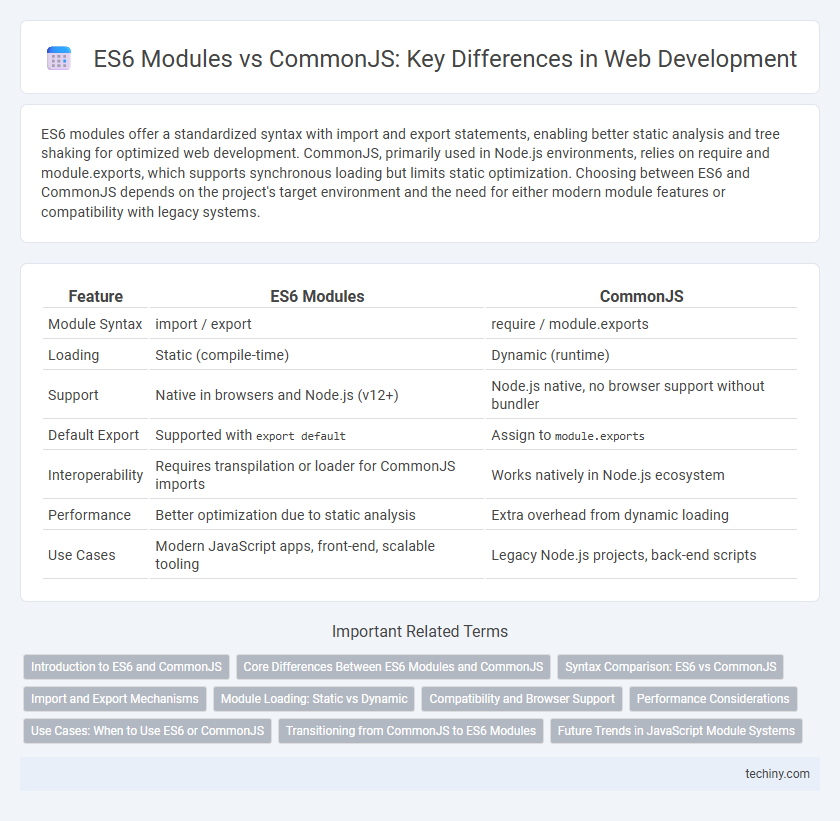ES6 modules offer a standardized syntax with import and export statements, enabling better static analysis and tree shaking for optimized web development. CommonJS, primarily used in Node.js environments, relies on require and module.exports, which supports synchronous loading but limits static optimization. Choosing between ES6 and CommonJS depends on the project's target environment and the need for either modern module features or compatibility with legacy systems.
Table of Comparison
| Feature | ES6 Modules | CommonJS |
|---|---|---|
| Module Syntax | import / export | require / module.exports |
| Loading | Static (compile-time) | Dynamic (runtime) |
| Support | Native in browsers and Node.js (v12+) | Node.js native, no browser support without bundler |
| Default Export | Supported with export default |
Assign to module.exports |
| Interoperability | Requires transpilation or loader for CommonJS imports | Works natively in Node.js ecosystem |
| Performance | Better optimization due to static analysis | Extra overhead from dynamic loading |
| Use Cases | Modern JavaScript apps, front-end, scalable tooling | Legacy Node.js projects, back-end scripts |
Introduction to ES6 and CommonJS
ES6 introduced native JavaScript modules using the `import` and `export` syntax, enhancing modularity and static analysis capabilities. CommonJS, primarily used in Node.js, relies on `require()` and `module.exports` for synchronous module loading, suited for server-side applications. ES6 modules support asynchronous loading and tree shaking, optimizing modern web development workflows.
Core Differences Between ES6 Modules and CommonJS
ES6 modules use static imports and exports, enabling compile-time optimization and tree shaking, while CommonJS relies on dynamic require statements executed at runtime. ES6 modules support asynchronous loading and have strict mode enabled by default, whereas CommonJS modules are synchronous and operate in standard mode unless explicitly set. The difference in scope handling is notable: ES6 modules have their own local scope with live bindings, contrasting with CommonJS exports that are copies of values assigned at runtime.
Syntax Comparison: ES6 vs CommonJS
ES6 modules use the `import` and `export` syntax, enabling static analysis and tree shaking by defining dependencies at compile time, whereas CommonJS relies on `require()` and `module.exports` for dynamic module loading. ES6 supports named exports and default exports, promoting better modularization, while CommonJS primarily exports a single object or function. The syntax differences impact performance optimization and compatibility, with ES6 becoming the standard for modern JavaScript applications.
Import and Export Mechanisms
ES6 modules use static import and export statements allowing for compile-time optimization and tree shaking, improving performance and reducing bundle size. CommonJS relies on dynamic require() calls and module.exports, which are resolved at runtime, limiting optimization opportunities. ES6's syntax enables better interoperability with modern JavaScript tools and supports asynchronous loading, contrasting with CommonJS's synchronous behavior.
Module Loading: Static vs Dynamic
ES6 modules use static loading, enabling tools like tree shaking and improved optimization by analyzing imports at compile time. CommonJS employs dynamic loading, allowing modules to be loaded conditionally or during runtime, which offers flexibility but hinders static analysis. The static nature of ES6 modules enhances performance and bundling efficiency in modern web development workflows.
Compatibility and Browser Support
ES6 modules (ESM) offer native browser support, enabling direct use without bundlers in modern environments, while CommonJS (CJS) is primarily designed for Node.js and lacks native browser compatibility, requiring tools like Browserify or Webpack for frontend use. ES6 modules support asynchronous loading and better tree-shaking capabilities, enhancing performance and optimized bundle sizes in web applications. Despite growing ESM adoption, CommonJS remains widely used in legacy Node.js projects, necessitating compatibility layers when integrating with modern ES6-based codebases.
Performance Considerations
ES6 modules offer faster static analysis and better tree-shaking capabilities compared to CommonJS, which can lead to smaller bundle sizes and improved runtime performance. CommonJS uses synchronous loading, causing delays during module resolution, while ES6 supports asynchronous loading mechanisms that optimize load times. In modern web development, ES6 modules are preferred for their improved execution speed and enhanced optimization potential in bundlers like Webpack and Rollup.
Use Cases: When to Use ES6 or CommonJS
ES6 modules excel in modern web development environments with native support in browsers and bundlers like Webpack, making them ideal for client-side applications and projects leveraging tree-shaking for optimized performance. CommonJS remains the dominant choice for Node.js applications and server-side scripts due to its synchronous loading and mature ecosystem compatibility. Choosing ES6 is preferable for modular, maintainable front-end codebases, while CommonJS suits legacy projects or modules requiring dynamic imports in backend environments.
Transitioning from CommonJS to ES6 Modules
Transitioning from CommonJS to ES6 modules involves replacing `require()` and `module.exports` with `import` and `export` syntax, enabling better static analysis and tree shaking in modern JavaScript bundlers like Webpack and Rollup. ES6 modules support asynchronous loading and have a strict mode by default, enhancing performance and security compared to CommonJS's synchronous loading model. Adopting ES6 modules improves code maintainability and compatibility with future JavaScript standards.
Future Trends in JavaScript Module Systems
ES6 modules have become the standard in JavaScript development due to their native support in browsers and improved static analysis for tools, outperforming CommonJS's synchronous loading model. Future trends indicate a stronger shift towards ES6 modules as build tools and runtime environments optimize for asynchronous module loading and tree-shaking capabilities. The growing adoption of ES modules in server-side environments like Node.js signals a unified module system that enhances compatibility and performance across client and server applications.
ES6 vs CommonJS Infographic

 techiny.com
techiny.com